The Term “En Plein Air” came from the french word that means “Outdoors” in English. Pioneering in the early nineteenth century by John Constable, it gained popularity among impressionist painters because of its introduction of painting tubes and portable easels.
Plein air painting, developed in the 19th century, captures the moments and light from nature and everyday life. Lightweight tools for painting, rapid compositions, and fast-drying capabilities are the most crucial attributes that make the watercolor the best medium for Plein air painting.
While Plain Air painting can be done for all forms of paintings in all mediums, studying the masters and their painting styles among impressionists, it can be concluded that watercolor was the most popular among them.
Preparing for Plein air painting
Planning your painting
The most important thing for Plein air painting is to plan for it. It takes much time to get outside and paint. We all are comfortable with indoor painting in our studio or corner desk where no one is looking at us what we are painting, and there is no fear of getting judged. The scenario is entirely different when you paint outdoor.
You get the best of lighting, the best help from mother nature, you will see the vibrant natural color, people, and harmony, and on the other hand, you will be destructed by so many things. There will be many sounds and noises, lots of people will be inquisitively looking over your shoulder, and lots of natural obstacles like heavy heat, wind, or rain may create obstacles.
Having the mindset to perform outdoor
It is sort of like doing Youtube videos nowadays. You will need to get out of that stigma about what others will think. Having a clear mindset that you are only improving your art skill and getting the best help from mother nature is the essential thing that you will need to think about.
From my experiences, I can tell that most people will be happy to see your painting. No one will be judging you. Instead, people will come and socialize with you, and so many of them will be eager to learn the technique from you. I have seen so many artists sell their Plein air paintings on locations! So it is an excellent showcase for an artist.
Have a firm mindset and make it happen to go out and paint outdoor.
Choosing the right time of the day for painting
Once you have prepared your plan, the next best thing is to find out the right timing for that type of painting. For example, if you have decided to paint a seascape, think about what exactly you want to include in the painting. Will there be people? Will it be nature only? Are you willing to paint some sunset color? Or sunrise color.
You can see where it is going; proper timing is essential.The right timing in the right place makes a pein air painting most successful.Check out the weather, and find out the right time of the day you will need to go out.
If you want to paint the morning scene, try to be at the place early morning as you may need to do some quick setup. You will not want to lose the sunlight that you wanted to capture by setting up the easel and getting ready to paint.
Finding the right subject to draw
More often, we try to paint pretty things. Some things are beautiful to look at, some are good at photography, but not all are excellent subjects to paint.
The use of lights and the simplicity of shapes in paintings make a painting beautiful and more amusing to look at. Choosing the natural set or very ordinary-looking scene is best for Plein air painting if you can ideally use light and shadow. Ordinary-looking scenes with extraordinary lighting effects are more eye-catching.
Everyone paints famous places, famous monuments or famous buildings, but my advice would be to paint ordinary-looking subjects.
Essential tools required for Plein air painting
Backpack
Depending on the type of easel you will be using, the size of the backpack will vary. If you are using a french easel, you can carry your painting, some quarter sheets, and brushes inside that easel. You will need to carry a water bottle, a water container, and some paper towels inside your backpack.
Easel
There are many lightweight easels available on the market. I am not to review all of these. Consider the weight and palette holding capabilities on your easel when you buy them. A french is an excellent choice for Plein air painting that serves most of the purposes. However, this depends on the artist’s ease of use, and some artists prefer custom-made tripod easels as needed.
Sketching tools
This includes 2B, 4B, or 6B pencils, pens required brushes, and paint tubes. I would not recommend too many paint tubes for Plein air painting to carry on.
Primary colors and some secondary colors are best for Plein air painting. Primary colors need to be selected for both warm and cool tones.
I suggest Ultramarine blue and cobalt blue, Burnt Sienna, Yellow Ochre, burnt umber, cadmium red, and Chinese white, and one or two extra colors would be best. Extra color depending on what subject you are painting. For example, painting seascape cobalt turquoise or for trees or forest sap green can be helpful.
Other essential tools
As mentioned previously, you will need a hat with a net for some cases. As I remember painting on the south island of New Zealand will be very uncomfortable for sandflies if you do not wear a hat with nets. Besides, sunscreens, raincoats, tools, water containers, and paper towels are needed for Plein air painting.
Six essential techniques for outdoor painting
The drawing or plain sketching
Sketching techniques are the easiest of all. You can sit down on a beach, cafe, or anywhere on location and sketch with pencils or pen. You will not need to paint with color or anything.
Using shades or hatches, you can make suitable compositions that will help you make a good painting in your studio.
Notan Sketching
Notan, pronounced No Tan, helps identify patterns and shapes of an object or compose a scene by using light and dark tones. Only one dark tone is used to identify darkness, and surface white implies lightness in this technique to study the tonal value.
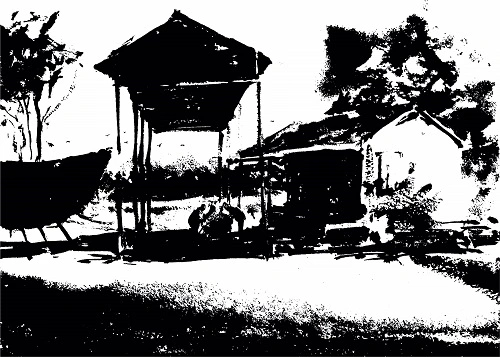
Many painters used this technique which proved to be very helpful for composition. This technique ignores any color, instead emphasizing dark value and light value.
Value Study
A value study breaks down a scenery or object into multiple shades of grey tones to identify the shape with lights and shadow and compose a painting that defines a positive and negative relationship that is visually interesting.
One can use various tones of grey or other dark colors to construct a painting that can give a quick view of entire compositions before committing to the original painting.
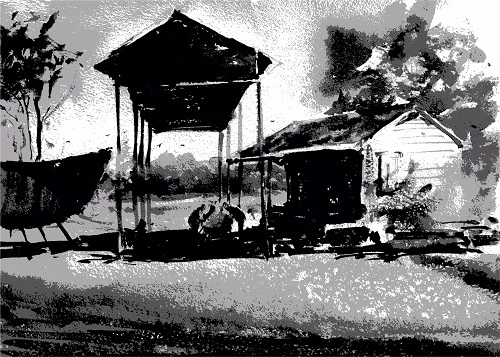
This technique helps to understand the fundamentals of three-dimensional effects on paintings.
Pen and wash or line and wash
This technique is prevalent among urban sketchers.
The pen and Wash technique, often known as line and wash drawing, is a drawing by pen or similar equipment on a paper and then tinting it with the various tone of ink or watercolor. In the early days, artists used twigs as pens to create exciting textures for lines.
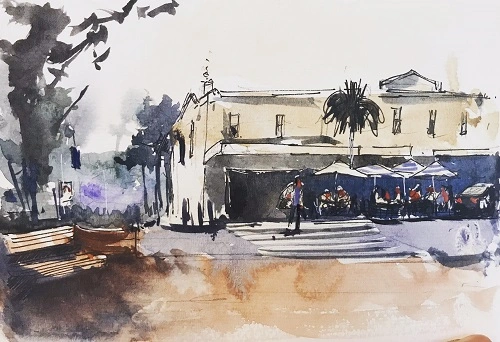
You will need a pen and a sketchbook to draw quick outlines of your subject and then tint them with colors. Sometimes the pen is used again to mark darker areas.
If the pen is used before applying a wash of color, the ink must be waterproof to avoid smudging.
The color sketching
Color sketching is sketching without using any pencils or pen and finishing the complete work using a brush and pigments. This technique proved to be very artistic, and some of them became award-winning art. Famous artist John Singer Sargent often used this technique, and since then, it has become trendy among artists.
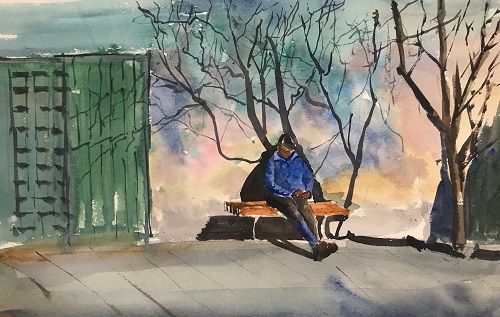
You will need some brushes and paint and a sketchbook for this. This technique also takes less time as no pre-drawing is necessary, and anyone can do it sitting on a park bench, in a cafe, or even inside a car.
Painting on the location
The most critical stage of painting outdoor is to finish the whole painting outside, starting from composition to your end brush stroke. It is very satisfying for a painter to finish the whole painting in one sitting.
It is possible for a watercolor artist but hard for oil painters unless you are painting in alla-prima style.
Alla-prima is a method of painting in a single application of pigments on the surface that may primarily involve wet in wet technique.
Initial washes or layers get dried up fairly quickly in watercolor, so the problematic job here is to keep the painting alive by making it wet with water spray
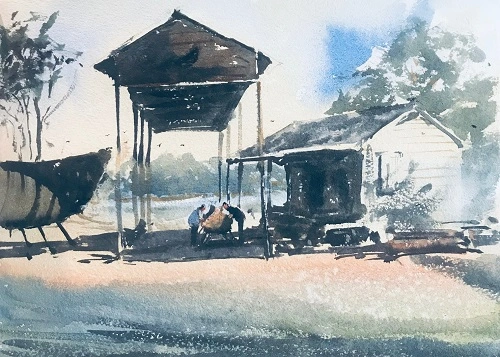
The Practicalities of painting on the location
When painting in a location for a landscape painting, always look for mood and atmosphere. Do not concentrate on the subject. Mood and atmosphere will come from the environment and quality of the light around you and the tonal quality of its application.
- Avoid the full sun as that may make your painting dry up faster than usual. You will not want your painting drying up fast; instead, as long as the paint is wet, that is alive, and error correction is possible.
- Avoid painting in intense sunlight without using an umbrella. Intense light will reflect on your paper, and you will be applying too much pigment than the necessary amount, resulting in too dark or too contrast. When using an umbrella, avoid using a colorful umbrella as the defused color of that umbrella may cause and judgemental error in your painting when applying colors.
- Avoid using the very bright colored full sleeve, which may reflect on your eyes while painting.
- Wear a hat if possible, and put sunscreen on if you live in one of those tropical countries. You may need a hat with a net in some coastal areas where sand flies are seen.
Benefits of Painting outdoors
Watercolor painting is a spontaneous reaction to your visual understanding of your surroundings. Painting on location does not have to be the final piece of art.
Instead, it is the instant reaction of your brush on the paper while observing the subject. This is how a watercolor painting should be. The more spontaneous it is, the more beautiful the piece of art will be.
Plein air painting can be a simple study of a subject at a specific time of the day that can, later on, create a visual impact on you when you will be using that study on your final painting in the studio.
Here are some benefits you will get.
Dramatic improvement of your style:
It will create a dramatic improvement in your art style. Your piece of art will have a more natural tonal value that will be much closer to reality.
Your style will have less saturated color and be more natural; you will be leaning towards tonal painting like old masters.
Getting a hand on unique shapes from nature:
By observing nature, an artist tends to create a unique painting style on the same subject that other painters miss who paint in the studio. Most of the time, we paint from the photograph in the studio. This habit creates a style that may be visually beautiful, but we compromise the uniqueness.
Finding contrast when painting outdoors
Mood extends our imagination; the atmosphere helps that. We observe that closely when we are outdoors. We can easily create a subject that contrasts with another or even nature. That makes the painting unique.
Combine elements found in your sketchbook
If you look at your sketchbook that contains all your outdoor paintings, you will never be out of inspiration or ideas about what to paint. By combining multiple subjects or elements, you can create multiple final paintings in your studio.
Composition made easy
There are different types of compositions that I will discuss another time on composition topics that can easily be applied when you are painting outdoors.
Painting from a photograph restricts us from changing the composition of the painting and visualizing what will work and what will not. Painting outdoors eliminates this hesitancy, and you can quickly view the subject from a different angle and do a quick sketch and compare which works best for you.
Same subject with different lights
You will never run out of the idea. Even going to the same place every time and painting the same subject every time but at different times of the day, you will do multiple unique compositions for the same study.
Painting outdoors makes your subject more precise but visually catchy
This is my favorite takeaway from Plein air painting. We usually do not paint from the photograph taken against the sunlight just because the photo comes out almost as a silhouette.
Furthermore, that is the reason the subject gets more simple to paint yet visually turns out very tonal. If your subject is too complex, my advice would be to paint against the light, paint the atmosphere, and you will find your painting visually stunning.
How to Improve your Plein air painting skills
Be spontaneous
Always be very spontaneous with the change of the lights. That will make your painting more lose style.
Not too many washes
Try to finish your painting in less than three washes. Then, in the end, it finishes it up with delicate details. There should be one initial wash, then one to implement values.
Do not use large size paper.
Plein air painting is not for your finished painting in most cases. Though the work of a most experienced artist becomes like a finished painting, you would intend to paint in a smaller size paper and later in the studio makes a more significant size painting from that one. Keep your Plein air work with you always; they are your memories.
Painting with groups:
Find a local group to join. Having similar-minded artists around you will benefit your learning path. You can share your skills and tips, and tricks. Moreover, it is beneficial for building a network that will come in handy in your painting career.
